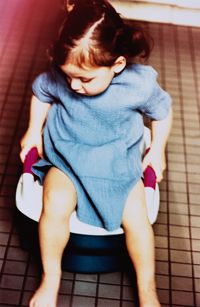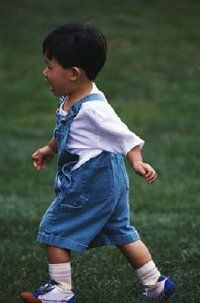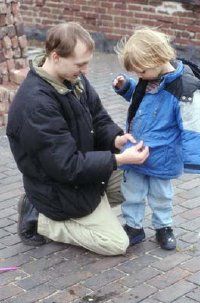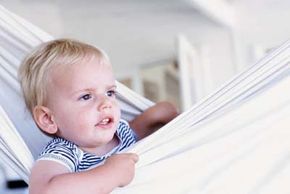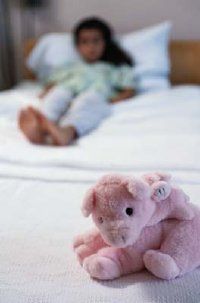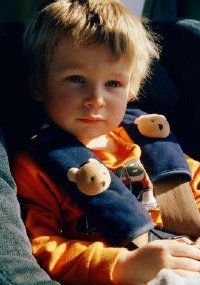You will suspect your child is ready for potty training if wearing a wet or soiled diaper has become uncomfortable and distasteful to him or if he sometimes tells you or lets you know in some other way that urination or defecation is about to take place. Before you start, let the child observe you and any sibling in the bathroom; an older brother or sister is usually a great role model and an enthusiastic one. Get several pairs of underpants -- the looser, the better -- and let your child practice pulling them up and down. Look in your bookstore or library for some of the excellent potty-training books available for children, and read them to your child.
Decide whether your child will use a potty chair or the big toilet, with or without an adapter. The advantages of the potty chair are that it is childsize, close to the floor, and easy to get on and off. The adapter takes no extra space, doesn't need emptying, and allows your child to skip the middle step of changing from the chair to the big toilet. Simply teaching your child to use the big toilet is, of course, easiest of all, if the child is large enough and not frightened.
If you choose the potty chair, look for one in which the pot removes easily for emptying; you want your child to take over this task as soon as possible. If you opt for the seat adapter, consider one that folds up conveniently for travel. If your child is a boy, you need a shield, either built-in or attachable, to deflect the flow of urine because boys do not stand up to urinate at first. Do not use a chair or adapter that has a shield for a little girl; instances of injury to the labia have been reported. If you decide on the potty chair, set it up some time before you start training your child so it becomes familiar. Let the child sit on it, fully clothed, if he or she wishes, when you are in the bathroom together.
Another decision you must make concerns terminology. Children can handle the words for body parts easily enough, but the words urinate and defecate are more difficult, and they or substitutes for them will, of course, be used far more frequently. Most families settle on more casual words, such as pee and BM. Remember, there is a fine line between the acceptable and the crude; a word or term that sounds cute coming from a two year old may not be so at all from a five year old.
Still another decision to make regards rewards for successful performance during potty training. Parents disagree; some disapprove heartily of using material rewards for the accomplishment of what they see as a natural and normal step in development, while others see no harm in the practice and think it helps inspire a child to earlier success.
Among the latter, there are those who reward their children with treats, such as cookies, nuts, or raisins, and those who prefer to use small, inexpensive presents instead of food. One material gift all children get is a supply of "big girl" or "big boy" pants, often introduced with some fanfare by parents and usually thrilling to a child. Some parents who don't believe in any kind of concrete reward other than potty-training pants like to mark a child's progress with colored stars on a calendar.
All parents do agree that praise is a highly suitable and effective reward. Praise generously, they say, but not so lavishly your child begins to think of bowel and bladder control as earth-shaking achievements, more important than they really are and, possibly, as tools to manipulate their parents.
Hopefully now you've assessed that you and your child are ready to start potty training. In the next section, we will learn how to begin the process.
This information is solely for informational purposes. IT IS NOT INTENDED TO PROVIDE MEDICAL ADVICE. Neither the Editors of Consumer Guide (R), Publications International, Ltd., the author nor publisher take responsibility for any possible consequences from any treatment, procedure, exercise, dietary modification, action or application of medication which results from reading or following the information contained in this information. The publication of this information does not constitute the practice of medicine, and this information does not replace the advice of your physician or other health care provider. Before undertaking any course of treatment, the reader must seek the advice of their physician or other health care provider.
